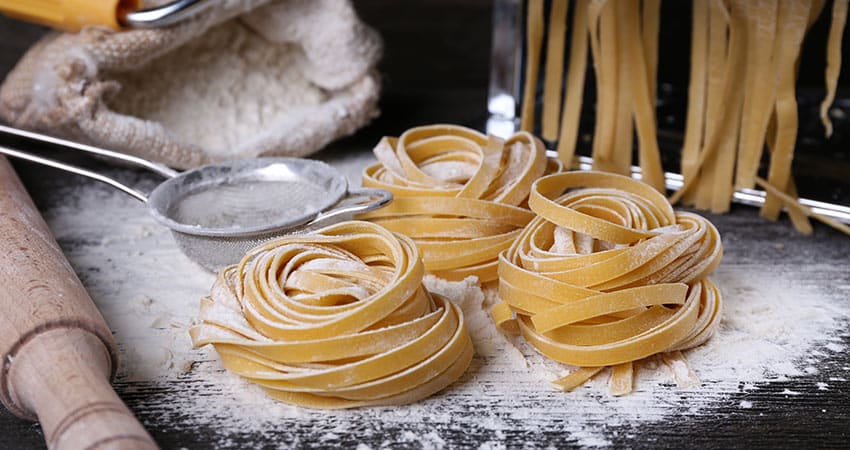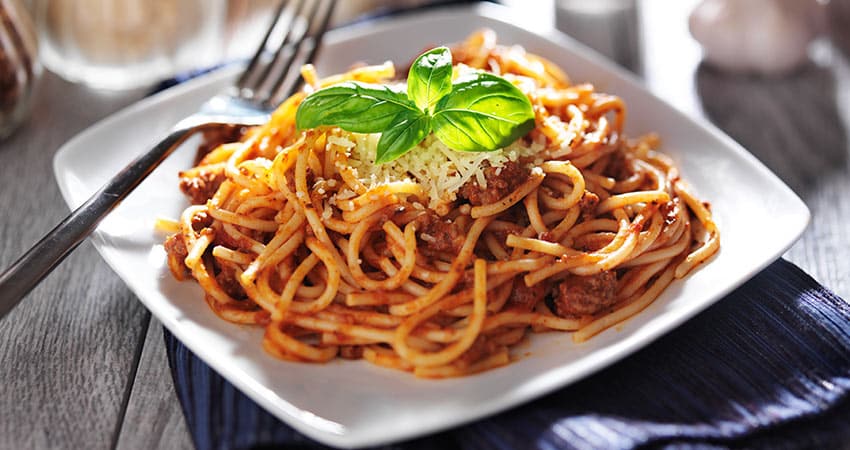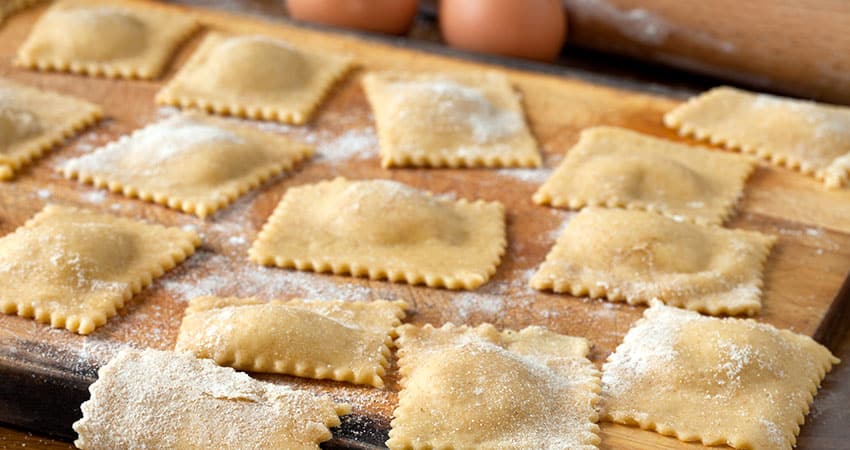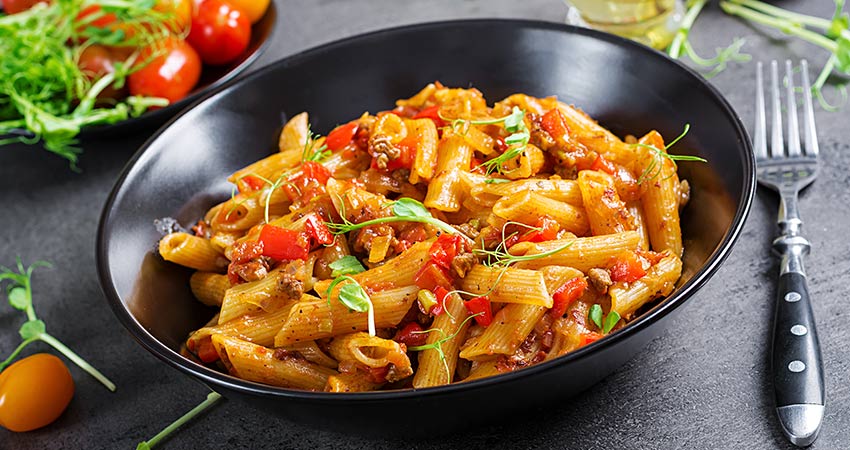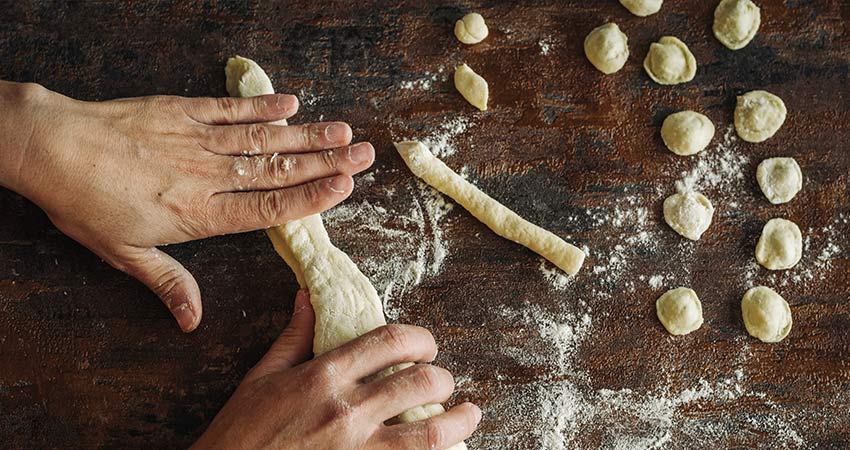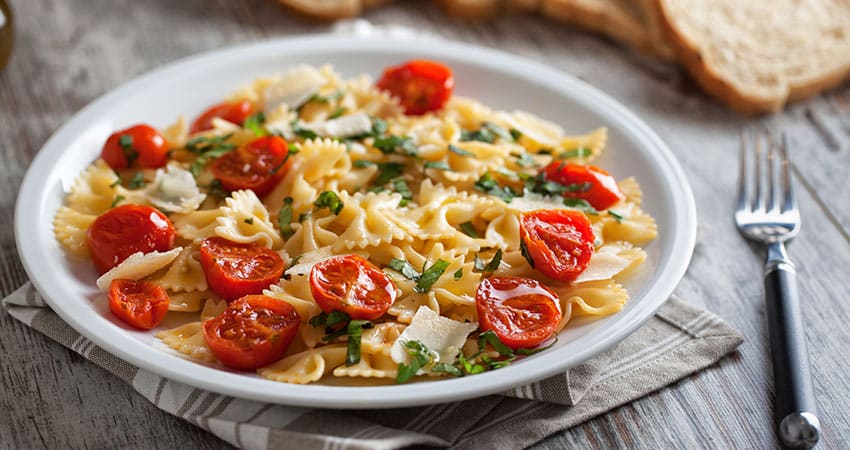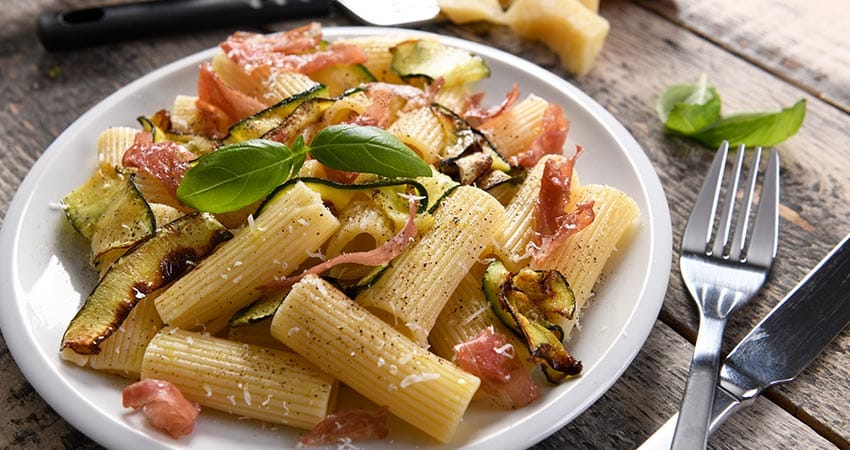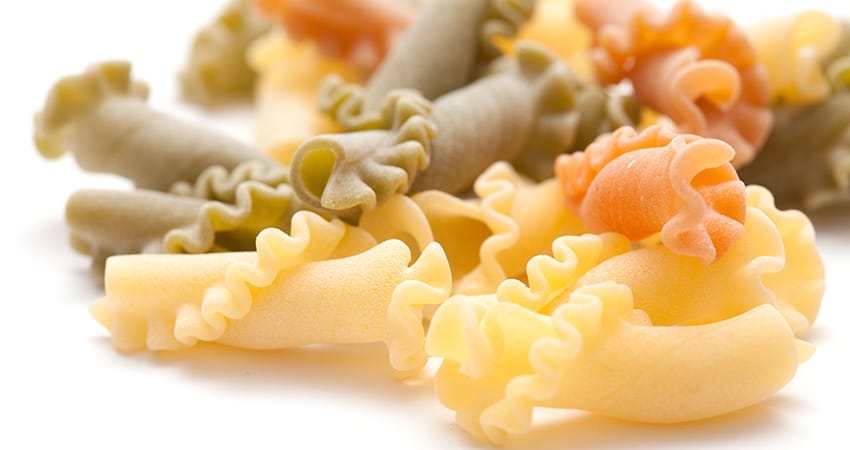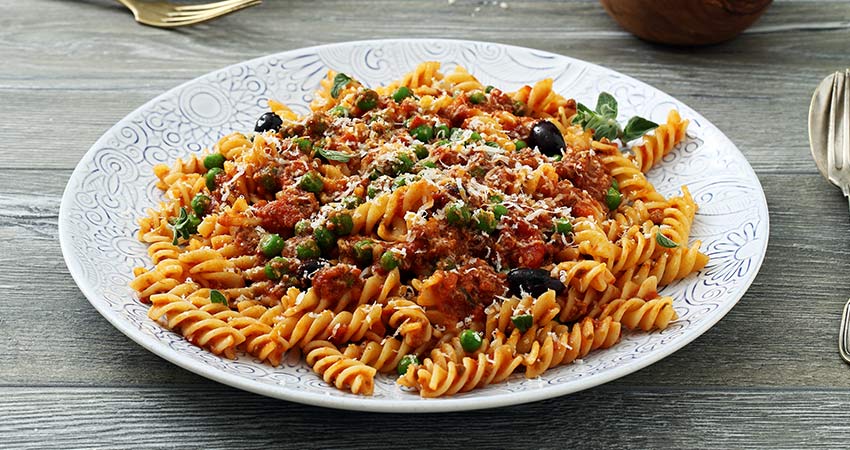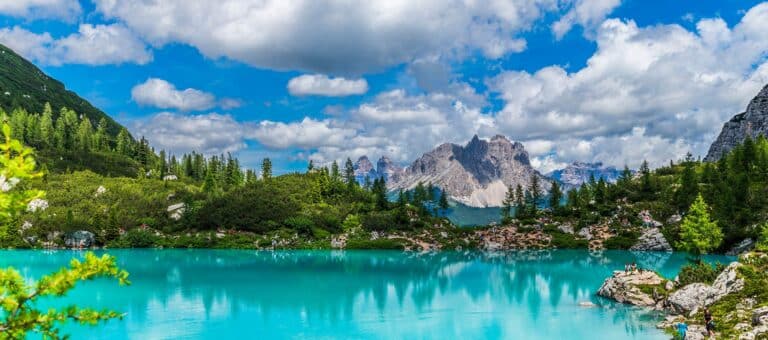When you travel around Italy, it feels as if pasta is served everywhere. Here is the happy truth… It is! Dried and fresh pasta comes in at least 310 shapes and is called by 1,300 names, depending upon which part of Italy you’re in. For instance, the pasta cavatelli has 28 different names. In Italy, pasta is more than just a food. It is a staple that’s important to the identity of Italian people. Hearty, traditional, and community-oriented, it speaks to their spirit.
Italy leads the world in pasta production, making 3½ million tons each year with more than half of it going to foreign markets. The USA produces 2 million tons. Turkey comes in third, exporting more than 1½ million tons to 160 countries, mostly Africa, Venezuela, and Japan. The world, it seems, is in love with pasta.
There are four standard ingredients: Flour, eggs, olive oil, and salt. By mixing other ingredients into a bowl of fresh-cooked pasta, you can create a genuine taste sensation. Consider adding any combination of parmesan, butter, garlic, olive oil, shrimp, spinach, mushrooms, salami, artichoke hearts, capers, olives, sundried tomatoes, or pesto. Heaven.
Emilia-Romagna Region: Tagliatelle
From the Italian meaning “cut,” this pasta was created for a banquet in 1487. Lucrezia Borgia visited Bologna on her way to the town of Ferrara to marry Duke Alfonso D’Este. The Bentivolgio’s family chef took sheets of pasta and cut them into ribbons, as a homage to Lucrezia’s long blonde hair. The flat surface of ¼ inch width holds sauce perfectly, especially the classic Bolognese.
If you’re in Bologna, stop in the Chamber of Commerce. A glass case within has a solid gold replica of a piece of tagliatelle, in what is considered to be the perfect width of ¼ inch uncooked, and 5/16th of an inch, cooked.
The region of Emilia-Romagna is the heart of central Italy. Rome built a road here in 187 BC. In the Middle Ages, pilgrims passed through, heading to Rome. The city of Ravenna became an important part of the Byzantine Empire. The rich farm lands and vibrant cities of Emilia-Romagna make it ideal to explore.
Sicily: Spaghetti
Americans eat more than 1.5 million pounds of spaghetti each year; that’s enough pasta to circle the planet nine times. It was born in 12th century Palermo, Italy. Originally the noodles were twice as long as those we have today, measuring almost 20 inches.
This versatile pasta can be served as Spaghetti alla puttanesca, a tangy dish from southern Italy with tomatoes, olive oil, olives, capers, and garlic. Spaghetti alla Nerano, from a village near Naples, has fried zucchinis and provolone. Spaghetti and meatballs is Italian-American and should be served with meatballs on the side! Spaghetti alle vongole (spaghetti with clams) is especially popular in Central Italy, including Rome and Campania.
The Piedmont Region: Agnolotti
This pasta is square, crimped, and stuffed with meat—it’s the main event in northwestern Italy. Agnolotti al Plin (Plin translates as a pinch) is pinched with the cook’s thumb and index finger to close the edges of the pasta in order to seal the meat and juices inside. Agnolotti can be added to a broth or soup, but most people like it best when it’s cooked in a pan with sage and butter, then dusted with white truffle.
The Piedmont region is basically rural, and it was part of the French principality of Savoy until the 16th century. Medieval castles and sacred mountains are built into the side of the Alps’ foothills. While exploring the Piedmont, head to one of the best Egyptian museums in the world in Turin. For wine tasting? Southern Piedmont produces some of the most robust red wines in the world.
The Campania Region: Penne
Penne is Italy’s most popular pasta. It is an extruded cylindrical pasta with its ends cut at an angle. The name comes from ‘penna’, which translates as ‘feather’ or ‘quill’. We know the exact date this pasta was first created. In 1865, Giovanni Battista Capurro patented a machine that could cut tubes of pasta on the diagonal. This eliminated the need to cut pasta with scissors and was first used in a village, San Martino d’Albero, near Genoa.
The Campania Region is situated in the shadow of Mount Vesuvius. It is home to rich plains, the spectacular Amalfi Coast, and a mysterious interior that still holds Greek and Roman ruins.
The Puglia Region: Orecchiette
Puglia’s special pasta is orecchiette, ‘or little ears.’ This is made only from durum wheat and water—cooks rarely use eggs. First the dough is rolled, then it’s cut into cubes. Each cube is pressed with a knife. The dough is swirled into a curl by dragging a knife across the board. The shape is turned over the thumb, so each has the cook’s thumbprint.
Orecchiette holds sauce wonderfully well. The traditional way to eat it is called orecchiette alla cime de rapa, or pasta with turnip tops. Broccoli and Cauliflower are also used—all are locally grown. If you’re in the area of Capitanata and Salento, you may find this pasta with tomato sauce, tiny meatballs, or a taste of ricotta.
The heel of Italy, Puglia has attracted Phoenicians, Greeks, Romans, and Crusaders with its magic light. This ancient fertile country is worth a long visit, for it has been influenced by the outside world for millennia.
The Lombardy Region: Farfalle
The bow-tie pasta, farfalle, gets its name from the Italian word for butterflies; it’s the signature pasta for the northwestern region of Lombardy. Farfalle comes in different sizes, but all are made from a rectangle of pasta with the center pinched and trimmed with a ruffled edge. This pasta is best served with a cream or tomato sauce.
There are white flour and whole wheat flour varieties, but it also comes in an astonishing range of colors. When beetroot is mixed with the dough, the pasta is red; spinach or basil makes it green; tomatoes, red; and cuttlefish ink, black. Red, green, and white pasta are often sold together in celebration of the Italian flag.
Most of Italy’s extraordinary lakes—Maggiore, Como, and Garda—are in the Lombardy Region. Romans adored this area, and it’s no wonder; it is simply magnificent. Ancient, Victorian, and medieval history runs wild here. Carefully planted gardens and villas hug lake shores. Culture, cuisine, and scenic wonders abound in this place that has inspired artists for centuries.
Rome: Rigatoni
Rigatoni is an important part of Italian cuisine and culture. Its roots are in Rome, but today you’ll find it throughout the country. It’s also a favorite in the USA. The name is derived from the Italian word ‘righe’, meaning ridges. It is wide and shaped like a cylinder. Sauces cling to the ridges, and the cylinder is large enough to hold vegetables and meat. Usually cooked al dente, it doesn’t collapse which makes it ideal for heavier pasta dishes.
The Tuscany Region: Gigli or Campanelle
Originally from Tuscany, many consider Gigli (also called Campanelle) to be the prettiest of pastas. Its creation dates back to the Italian Renaissance. The lilies of Tuscany’s legendary countryside are the inspiration for the shape of Gigli. Lilies have long been associated with Tuscany, and have been part of Florence’s coat of arms for almost 1,000 years. (In Latin, ‘florentia’ translates as ‘flowering,’ and the founder of Florence was Florinus da Cellino.)
This lovely pasta is perfect for thick cream sauces and vegetable-based sauces. It is also widely used in casseroles or any baked pasta dishes.
Tuscany has stunning landscapes dotted with Etruscan walls and graceful cypress trees. Vineyards, olive groves, villas, and castles roll up the soft hills. The Medici family, patrons of scientists such as Galileo, left a legacy of villas during the Middle Ages. Northern Tuscany, between Lucca and Florence, has wild mountains, cities abuzz with industry, and miles of farmland. Travelling through Tuscany is to travel in beauty and grace.
The Campania Region: Fusilli
Another Italian favorite, fusilli gets its name from ‘fuso’, meaning spindle. In small villages, fusilli is still made by hand by rolling spaghetti with a wire and then drying the pasta. This creates a short, twisted shape that looks like a corkscrew. Besides the plain or whole wheat varieties, as with other pasta, there are also colored versions. With the additions of basil, tomato, beetroot, or cuttlefish ink, the flavor is affected, so cooks are careful about what tinted pasta is served with. Meat and ricotta-based sauces are perfect for fusilli.
Pompeii, Herculaneum, the Amalfi Coast, and Capri are all part of Campania’s essential beauty.
Food is central to any Italy vacation. Known for the diversity of flavors that defines regional cuisine, pasta is always on the menu. Long or short, tubes that wrap around luscious meats and vegetables, and fanciful shapes that hold exquisite sauces are all yours to savor!
If you want Italian cuisine to be an integral part of your Italy vacation, simply let your Destination Expert know.


